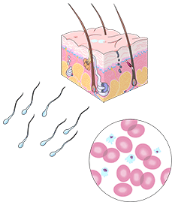Archival Notice
This is an archive page that is no longer being updated. It may contain outdated information and links may no longer function as originally intended.
Home | Glossary | Resources | Help | Contact Us | Course Map
Serology is the detection, identification, and typing of body tissues, either in native form or as stains or residues left at a crime scene. Most often, the tissue of interest is a body fluid such as blood or semen; however, other tissues such as hair or bone are encountered. The detection and identification process begins with a physical examination, followed by a screening test, and may include confirmatory identification and sample typing. Typing is the detection of genetically determined characters in the sample. A difference in type between the stain and reference sample from the postulated source may provide a positive elimination. If there is no elimination, the results can be evaluated against population frequency data to give a measure of the significance of the failure to eliminate.
The features of a good typing system are that it
- shows variability from person to person but is constant within one individual,
- is stable in shed form,
- can be detected reliably at the concentrations found in forensic samples,
- has a known and stable frequency of occurrence within the population.
|
Note: |
|
It is not required that a typing system be based on an inherited characteristic, although in practice they all are. |
The very presence of biological fluids, specifically blood and semen, may be an indication of a serious crime and of evidential value. The physical distribution of blood stains at the scene or on clothing may produce valuable information about the crime.
Characterization of biological fluids is often used to associate forensic evidence with an individual. Testing allows conclusions to be drawn as to the person from whom the fluid originated.
Additional Online Courses
- What Every First Responding Officer Should Know About DNA Evidence
- Collecting DNA Evidence at Property Crime Scenes
- DNA – A Prosecutor’s Practice Notebook
- Crime Scene and DNA Basics
- Laboratory Safety Programs
- DNA Amplification
- Population Genetics and Statistics
- Non-STR DNA Markers: SNPs, Y-STRs, LCN and mtDNA
- Firearms Examiner Training
- Forensic DNA Education for Law Enforcement Decisionmakers
- What Every Investigator and Evidence Technician Should Know About DNA Evidence
- Principles of Forensic DNA for Officers of the Court
- Law 101: Legal Guide for the Forensic Expert
- Laboratory Orientation and Testing of Body Fluids and Tissues
- DNA Extraction and Quantitation
- STR Data Analysis and Interpretation
- Communication Skills, Report Writing, and Courtroom Testimony
- Español for Law Enforcement
- Amplified DNA Product Separation for Forensic Analysts


